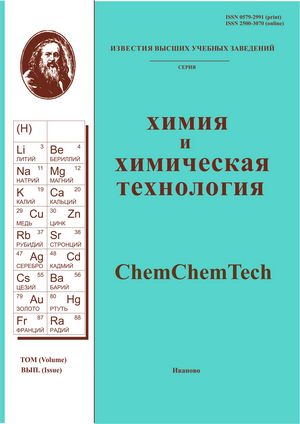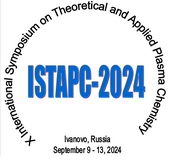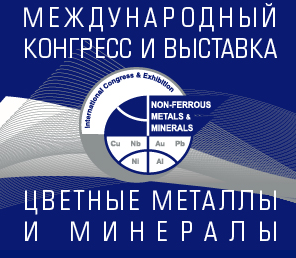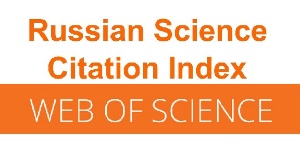ПРИМЕНЕНИЕ АНИОН-РАДИКАЛОВ СЕРЫ В ОРГАНИЧЕСКОМ СИНТЕЗЕ. ОПРЕДЕЛЕНИЕ ФОРМ СЕРЫ СПЕКТРАЛЬНЫМИ МЕТОДАМИ
Аннотация
Исследование реакций с участием анион-радикалов серы в органическом синтезе стало областью активных исследований в последние несколько лет. Особый интерес вызывает роль полисульфидных радикалов в электрохимических процессах литий–серных (Li-S) аккумуляторов. Исследование механизмов этих реакций имеет решающее значение для повышения производительности Li-S аккумуляторов. С целью обобщения и анализа наиболее актуальных литературных данных в обзоре представлены сведения по вопросам применения и изучения анион-радикалов серы в органическом синтезе и методах определения форм серы. Мы классифицировали и подробно обсудили спектры различных форм серы в ультрафиолетовом и видимом диапазонах. В статье описаны выбор растворителя, корреляция между свойствами растворителей, влияние природы растворителя на сдвиг полос поглощения частиц серы и на устойчивость анион-радикала, идентификация форм серы в ультрафиолетовой и видимой области спектра и возможность стабилизации анион-радикалов за счет комплексообразования с краун-эфирами. Полосы поглощения для S22-, S32-, S52-, S72- сильно перекрываются с полосами поглощения других частиц, и имеют при этом более низкую интенсивность, что приводит к разным выводам относительно распределения полисульфидов и разных форм серы в водной среде. Представленные в обзоре данные имеют прикладное значение, вносят вклад в понимание применения анион-радикалов серы в органическом синтезе и могут быть использованы для выбора метода определения форм серы и растворителя. Данная обзорная статья может быть интересной специалистам, занимающимся в данной области, и поможет спланировать исследования по изучению форм серы и интерпретации спектров различных форм серы.
Для цитирования:
Дмитриева Е.Д., Оськин П.В., Ковалева А.А., Осина К.В. Применение анион-радикалов серы в органическом синтезе. Определение форм серы спектральными методами. Изв. вузов. Химия и хим. технология. 2024. Т. 67. Вып. 3. С. 6-18. DOI: 10.6060/ivkkt.20246703.6875.
Литература
Müller A., Bernt K. Sulfur: its significance for chemistry, for the geo-, bio-, and cosmosphere and technology. Elsevier. 2016. DOI: 10.1007/978-981-15-3401-0
Wujcik K.H., Pascal, T.A., Pemmaraju C. D., Devaux D., Stolte W.C., Balsara N.P., Prendergast D. Character-ization of polysulfide radicals present in an ether‐based electrolyte of a lithium–sulfur battery during initial dis-charge using in situ X‐ray absorption spectroscopy experiments and first‐principles calculations. Adv. Energy Ma-ter. 2015. V. 5. N 16. DOI: 10.1002/aenm.201500285.
Waluś S., Barchasz C., Colin, J. F., Martin J. F., Elkaïm E., Leprêtre J. C., Alloin F. New insight into the working mechanism of lithium–sulfur batteries: in situ and operan-do X-ray diffraction characterization. Chem. Comm. 2013. V. 49. N 72. P. 7899-7901. DOI: 10.1039/C3CC43766C.
Cortese-Krott M.M., Gunter G. Kuhnle C., Dyson A., Fernandez B.O., Grman M., DuMond J.F., Barrow M.P., McLeod G., Nakagawa H., Ondrias K., Nagy P., Bruce King S., Saavedra J.E., Keefer L.K., Singer M., Kelm M., A. R. Butler, Feelisch M. Key bioactive reaction products of the NO/H2S interaction are S/N-hybrid species, polysulfides, and nitroxyl. Proc. Natl. Acad. Sci. 2015. V. 112. N 34. P. E4651-E4660. DOI: 10.1073/pnas.1509277112.
See K.A., Leskes M., Griffin J.M., Britto S., Matthews P.D., Emly A., Ven A. van der, Wright D.S., Morris A.J., Grey C.P., Seshadri R. Ab initio structure search and in situ 7Li NMR studies of discharge products in the Li-S battery system. J. Am. Chem. Soc. 2014. V. 136. N 46. P. 16368-16377. DOI: 10.1021/ja508982p
Xiao J., Hu J.Z., Chen H., Vijayakumar M., Zheng J., Pan H., Walter E.D., Hu M., Deng X., Feng J., Liaw B.Y., Gu M., Deng Z.D., Lu D., Xu S., Wang C., Liu J. Following the transient reactions in lithium-sulfur batteries using an in situ nuclear magnetic resonance technique. Nano Lett. 2015. V. 15. N 5. P. 3309-3316. DOI: 10.1021/acs.nanolett.5b00521.
Wang H., Sa N., He M., Liang X., Nazar L.F., Balasubramanian M., Gallagher K.G., Key B. In Situ NMR Observation of the Temporal Speciation of Lithium Sulfur Batteries during Electrochemical Cycling. J. Phys. Chem. C. 2017. V. 121. N 11. P. 6011-6017. DOI: 10.1021/acs.jpcc.7b01922.
Mali G., Patel M.U., Mazaj M., Dominko R. Stable Crystalline Forms of Na Polysulfides: Experiment versus Ab Initio Computational Prediction. Chem. Eur. J. 2016. V. 22. N 10. P. 3355-3360. DOI: 10.1002/chem.201504242.
Kamyshny A., Goifman A., Gun J., Rizkov D., Lev O. Equilibrium distribution of polysulfide ions in aqueous so-lutions at 25 °C: A new approach for the study of polysulfides’ equilibria. Environ. Sci. Technol. 2004. V. 38. N 24. P. 6633-6644. DOI: 10.1021/es049514e.
Takata T., Saeki D., Makita Y., Yamada N., Kihara N. Aromatic hydrocarbon-catalyzed direct reaction of sulfur and sodium in a heterogeneous system: Selective and facile synthesis of sodium monosulfide and disulfide. Inorg. Chem. 2003. V. 42. N 12. P. 3712-3714. DOI: 10.1021/ic034084z.
Schmidt C., Seward T.M. Raman spectroscopic quantifi-cation of sulfur species in aqueous fluids: Ratios of relative molar scattering factors of Raman bands of H2S, HS−, SO2, HSO4−, SO42−, S2O32−, S3− and H2O at ambient conditions and information on changes with pressure and tem-perature. Chem Geol. 2017. V. 467. P. 64-75. DOI: 10.1016/j.chemgeo.2017.07.022.
Clark R.J.H., Cobbold D.G. Characterization of Sulfur Radical Anions Characterization of Sulfur Radical Anions in Solutions of Alkali Polysulfides in Dimethylformamide and Hexamethylphosphoramide and in the Solid State in Ultramarine Blue, Green, and Red. Inorg. Chem. 1978. V. 17. N I. P. 3169. DOI: 10.1021/ic50189a042.
Kim B.S., Park S.M. In Situ spectroelectrochemical studies on the reduction of sulfur in dimethyl sulfoxide solu-tions. J. Electrochem. Soc. 1993. V. 140. N 1. P. 115-122. DOI: 10.1149/1.2056070.
Gaillard F., Levillain E. Visible time-resolved spectroe-lectrochemistry: application to study of the reduction of sulfur (S8) in dimethylformamide. J. Electroanal. Chem. 1995. V. 398. N 1-2. P. 77–87. DOI: 10.1016/0022-0728(95)04144-1.
Martin R.P., Doub W.H., Jr., Julian Roberts L., Jr., Sawyer D.T. Electrochemical reduction of sulfur in apro-tic solvents. Inorg. Chem. 1973. V. 12. N 8. P. 1921-1925. DOI: 10.1021/ic50126a047.
Berberova N.T. The role of inorganic ion radicals in organic and inorganic reactions. SOZh. 1999. N 1. P. 28-34 (in Russian).
Chivers T., Elder P.J.W. Ubiquitous trisulfur radical anion: Fundamentals and applications in materials science, electrochemistry, analytical chemistry and geochemistry. Chem Soc Rev. 2013. V. 42. N 14. P. 5996-6005. DOI: 10.1039/C3CS60119F.
Steudel R. Inorganic Polysulfides Sn2− and Radical Anions Sn−. Elemental Sulfur und Sulfur-Rich Compounds II. 2012. P. 127-152. DOI: 10.1007/b13183.
Eckert B., Steudel R. Molecular spectra of sulfur molecules and solid sulfur allotropes. Topics Curr. Chem. 2012. P. 31-98. DOI: 10.1007/b11909.
Steudel R., Chivers T. The role of polysulfide dianions and radical anions in the chemical, physical and biological sciences, including sulfur-based batteries. Chem. Soc. Rev. 2019. V. 48. N 12. P. 3279-3319. DOI: 10.1039/C8CS00826D.
Chivers T., Drummond I. Characterization of the trisulfur radical anion S3- in blue solutions of alkali polysulfides in hexamethylphosphoramide. Inorg. Chem. 1972. V. 11. N 10. P. 2525-2527. DOI: 10.1021/ic50116a047.
Gaillard F., Levillain E., Lelieur J.P. Polysulfides in dimethylformamide: Only the radical anions S3- and S4- are reducible. J. Electroanal. Chem. 1997. V. 432. P. 29-138. DOI: 10.1016/S0022-0728(97)00192-7.
Shields T.C., Kurtz A.N. Active sulfuration of norbornenes. J. Am. Chem. Soc. 1969. V. 91. N 19. P. 5415-5416. DOI: 10.1021/ja01047a058.
Zhang G., Yi H., Chen H., Bian C., Liu C., Lei A. Trisulfur radical anion as the key intermediate for the synthesis of thiophene via the interaction between elemental sulfur and NaO t Bu. Org. Lett. 2014. V. 16. N 23. P. 6156-6159. DOI: 10.1021/ol503015b.
Kozhich D.T., Abramovich M.S., Arabey S.M. Modified preparative methods of synthesis of 2,5-diphenylthiophene and its derivatives. Coll. of art. of the II International scientific and practical conference "Processing and quality management of agricultural products". Minsk: BGATU. 2015. P. 256-259 (in Russian).
Li J.H., Huang Q., Wang S.Y., Ji S.J. Trisulfur Radical Anion (S3•-) Involved [1 + 2 + 2] and [1 + 3 + 1] Cycload-dition with Aromatic Alkynes: Synthesis of Tetraphenyl-thiophene and 2-Benzylidenetetrahydrothiophene Deriva-tives. Org. Lett. 2018. V. 20. N 15. P. 4704–4708. DOI: 10.1021/acs.orglett.8b02066.
Li J.H., Huang Q., Rao W., Wang S.Y., Ji S.J. A trisulfur radical anion (S3-) involved sulfur insertion reaction of 1,3-enynes: Sulfide sources control chemoselective synthesis of 2,3,5-trisubstituted thiophenes and 3-thienyl di-sulfides. Chem. Comm. 2019. V. 55. N 54. P. 7808–7811. DOI: 10.1039/C9CC03604K.
Jin S., Li S.J., Ma X., Su J., Chen H., Lan Y., Song Q. Elemental-Sulfur-Enabled Divergent Synthesis of Disul-fides, Diselenides, and Polythiophenes from β-CF3-1,3-Enynes. Angew. Chem. 2021. V. 60. N 2. P. 881–888. DOI: 10.1002/anie.202009194.
Su F., Chen S., Mo X., Wu K., Wu J., Lin W., Lin Z., Lin J., Zhang H.-J., Wen T.-B. Trisulfur Radical Anion-triggered Stitching Thienannulation: Rapid Access to Largely π-extended Thienoacenes. Chem. Sci. 2020. V. 11. N 6. P. 1503–1509. DOI: 10.1039/C9SC05332H.
Li B., Ni P., Huang H., Xiao F., Deng G.J. Three-Component Thieno[2,3-b]indole Synthesis from Indoles, Alkenes or Alkynes and Sulfur Powder under Metal-Free Conditions. Adv. Synth. Catal. 2017. V. 359. N 24. P. 4300–4304. DOI: 10.1002/adsc.201701106.
Ma J., Luo J., Jiang K., Zhang G., Liu S., Yin B. Access to Polycyclic Thienoindolines via Formal [2+2+1] Cycliza-tion of Alkynyl Indoles with S 8 and K 2 S. Org. Lett. 2021. V. 23. N 20. P. 8033–8038. DOI: 10.1021/acs.orglett.1c03035.
Wang M., Fan Q., Jiang X. Transition-Metal-Free Diarylannulated Sulfide and Selenide Construction via Radi-cal/Anion-Mediated Sulfur-Iodine and Selenium-Iodine Exchange. Org. Lett. 2016. V. 18. N 21. P. 5756–5759. DOI: 10.1021/acs.orglett.6b03078.
Wang M., Fan Q., Jiang X. Cu-catalyzed [2 + 2 + 1] cascade annulation of vinyl iodonium salts with elemental sulfur/selenium for the modular synthesis of thiophenes and selenophenes. New J. Chem. 2022. V. 46. N 3. P. 945–949. DOI: 10.1021/acs.orglett.6b03078.
Li J., Liu Y., Chen Z., Li J., Li J., Ji X., Chen L., Huang Y., Liu Q., Li Y. Synthesis of Substituted Thiophenes through Dehydration and Heterocyclization of Alkynols. J. Org. Chem. 2022. V. 87. N 5. P. 3555–3566. DOI: 10.1021/acs.joc.1c03114.
Jafarpour F., Rajai-Daryasarei S., Gohari M.H. Cas-cade cyclization versus chemoselective reduction: a sol-ventcontrolled product divergence. Org. Chem. Front. 2020. V. 7. N 21. P. 3374–3381. DOI: 10.1039/D0QO00876A.
Liu B.B., Bai H.W., Liu H., Wang S.Y., Ji S.J. Cascade Trisulfur Radical Anion (S3•-) Addition/Electron Detosyla-tion Process for the Synthesis of 1,2,3-Thiadiazoles and Isothiazoles. J. Org. Chem. 2018. V. 83. N 17. P. 10281–10288. DOI: 10.1021/acs.joc.8b01450.
Gu Z.Y., Cao J.J., Wang S.Y., Ji S.J. The involvement of the trisulfur radical anion in electron-catalyzed sulfur insertion reactions: Facile synthesis of benzothiazine derivatives under transition metal-free conditions. Chem Sci. 2016. V. 7. N 7. P. 4067–4072. DOI: 10.1039/C6SC00240D.
Zhang P., Yang L., Chen W., Liu M., Wu H. Synthesis of [1,4]Thiazino[4,3- a]indol-10-one Derivatives through Radical Anti Aza-Michael Addition of 2′-Aminochalcones. Org. Lett. 2021. V. 23. N 15. P. 6094–6098.
Liu X.-Y., Zhao Y.-W., Jiang T., Rao W., Wang Sh.-Y. Insertion Reaction of 2-Halo- N -allylanilines with K2S Involving Trisulfur Radical Anion: Synthesis of Benzothi-azole Derivatives under Transition-Metal-Free Conditions. Georg. Thieme. Verlag. 2021. V. 53. N 5. P. 971–977. DOI: 10.1055/s-0040-1706104.
Huang H., Qu Z., Ji X., Deng G.J. Three-component bis-heterocycliation for synthesis of 2-aminobenzo[4,5]thieno[3,2- d ]thiazoles. Org. Chem. Front. 2019. V. 6. N 8. P. 1146–1150. DOI:10.1039/C8QO01365A.
Chen L., Xia P., Du T., Deng, Y., Xiao Y. Catalyst-Free One-Pot Synthesis of Unsymmetrical Five- and Six-Membered Sulfur-Annulated Heterocyclic Perylene Diimides for Electron-Transporting Property. Org. Lett. 2019. V. 21. N 14. P. 5529–5532. DOI: 10.1021/acs.orglett.9b01847.
Tan W., Wang C., Jiang X. Green carbon disulfide surrogate via a combination of potassium sulfide and chloroform for benzothiazine-thione and benzothiazole-thione construction. Org. Chem. Front. 2018. V. 5. N 15. P. 2390-2394. DOI: 10.1039/C8QO00481A.
Mai Y.Z., Xie Y.Z., Zheng M.H., Zhou X., Jin J.Y. Fac-ile synthesis of pyronin-9-thione: Via a trisulfur radical an-ion mechanism. New J. Chem. 2021. V. 45. N 1. P. 19–22. DOI: 10.1039/D0NJ04808A.
Liu W., Chen C., Zhou P. Concise Access to α-Arylketothioamides by Redox Reaction between Aceto-phenones, Elemental Sulfur and DMF. Chem. Select. 2017. V. 2. N 20. P. 5532–5535. DOI: 10.1002/slct.201700866.
Fujisawa T., Hata K., Kojima T. The sulfurization of sterically hindered phenols with sulfur. A convenient syn-thesis of 4,4’-thio-bis-(2.6-dialkilpenols) and 2,6-dialkil-4-mercaptophenols. Synthesis. 1973. V. 1. P. 38–39. DOI: 10.1055/S-1973-22126.
Khabarov Yu.G., Prokshin G.F., Bokhovkin I.M., Gorbunova O.F. On the interaction of some model substances and lignin with potassium ferricyanide in the presence of sodium sulfide. Lesnoy Zhurn. 1979. V. 1. P. 77-79 (in Russian).
Li H., Tang X., Pang J.H., Wu X., Yeow E.K., Wu J., Chiba S. Polysulfide anions as visible light photoredox catalysts for aryl cross-couplings. J. Am. Chem. Soc. 2021. V. 143. N 1. P. 481–487. DOI: 10.1021/jacs.0c11968.
Wang S., Wang H., König B. Light-Induced Single-Electron Transfer Processes involving Sulfur Anions as Catalysts. J. Am. Chem. Soc. 2021. V. 143. N 38. P. 15530–15537. DOI: 10.1021/jacs.1c07785.
Nguyen K.X., Pham P.H., Nguyen T.T., Yang C.-H., Pham H.T. B., Nguyen T.T., Wang H., Phan N.T.S. Tri-sulfur-Radical-Anion-Triggered C(sp2)-H Amination of Electron-Deficient Alkenes. Org. Lett. 2020. V. 22. N 24. P. 9751–9756. DOI: 10.1021/acs.orglett.0c03846.
Li H., Chiba S. Synthesis of α-tertiary amines by polysul-fide anions photocatalysis via single-electron transfer and hydrogen atom transfer in relays. Chem. Catalysis. 2022. V. 2. N 5. P. 1128–1142. DOI: 10.1016/j.checat.2022.03.006.
Ai J.J., Liu B.B., Li J., Wang F., Huang C.M., Rao W., Wang S.Y. Fe-S Catalyst Generated in Situ from Fe(III)- And S3•--Promoted Aerobic Oxidation of Terminal Alkenes. Org. Lett. 2021. V. 23. N 12. P. 4705–4709. DOI: 10.1021/acs.orglett.1c01408.
Wang Y. The chromophore fading and spectroscopy analysis of lazurite in annealing treatment. Spectrochim. Acta A. 2021. V. 247. 119117. DOI: 10.1016/j.saa.2020.119117.
Tauson V.L., Goettlicher J., Sapozhnikov A.N., Mangold, S., Lustenberg E.E. Sulphur speciation in lazurite-type minerals (Na,Ca)8[Al6Si6O24](SO4,S)2 and their an-nealing products: a comparative XPS and XAS study. Eur. J. Miner. 2012. V. 24. N 1. P. 133–152. DOI: 10.1127/0935-1221/2011/0023-2132.
Platonov A.N., Tarashchan D.N., Belichenko V.P., Povarenykh A.S. Spectroscopic study of sulfide sul-fur in some frame aluminosilicates. Konstitutsiya Svoystva Mineralov. 1971. V. 5. P. 61-71 (in Russian).
Climent-Pascual E., de Paz J. R., Rodríguez-Carvajal J., Suard E., Sáez-Puche R. Synthesis and characteriza-tion of the ultramarinetype analog Na 8-X[Si6Al6O24] (S 2,S3,CO3)1-2. Inorg Chem. 2009. V. 48. N 14. P. 6526–6533. DOI: 10.1021/ic900438c.
Ostroumov M., Fritsch E., Faulques, E., Chauvet O. Etude spectrometrique de la lazurite du pamir, Tajikistan. Canad. Mineral. 2002. V. 40. P. 885–893. DOI: 10.2113/gscanmin.40.3.885.
Rejmak P. Computational refinement of the puzzling red tetrasulfur chromophore in ultramarine pigments. Phys. Chem. Chem. Phys. 2020. V. 22. N 39. P. 22684–22698. DOI: 10.1039/D0CP03019H.
Fleet M.E., Liu X. X-ray absorption spectroscopy of ultramarine pigments: A new analytical method for the polysulfide radical anion S3- chromophore. Spectrochim. Acta B. 2010. V. 65. N 1. P. 75–79. DOI: 10.1016/j.sab.2009.11.008.
Reinen D., Lindner G.G. The nature of the chalcogen colour centres in ultramarine-type solids. Chem. Soc. Rev. 1999. V. 28. N 2. P. 75–84. DOI: 10.1039/A704920J.
Clark R.J.H., Franks M.L. The resonance Raman spec-trum of ultramarine blue. Chem. Phys. Lett. 1975. V. 34. N 1. P. 69–72. DOI: 10.1016/0009-2614(75)80202-8.
Gobeltz-Hautecoeur N., Demortier A., Lede B., Lelieur J. P., Duhayon C. Occupancy of the sodalite cages in the blue ultramarine pigments. Inorg. Chem. 2002. V. 41. N 11. P. 2848–2854. DOI: 10.1021/ic010822c.
Osticioli I., Mendes N.F.C., Nevin A., Gil F.P.S.C., Becucci M., Castellucci E. Analysis of natural and artifi-cial ultramarine blue pigments using laser induced break-down and pulsed Raman spectroscopy, statistical analysis and light microscopy. Spectrochim. Acta A. 2009. V. 73. N 3. P. 525–531. DOI: 10.1016/j.saa.2008.11.028.
Gobeltz N., Demortier A., Lelieur J.P., Duhayon C. Correlation between EPR, Raman and colorimetric characteris-tics of the blue ultramarine pigments. J. Chem. Soc. Farad. Trans. 1998. V. 94. N 5. P. 677–681. DOI: 10.1039/a707619c.
Clark R.J.H., Dines T.J., Kurmoo M. On the nature of the sulfur chromophores in ultramarine blue, green, violet, and pink and of the selenium chromophore in ultramarine selenium: characterization of radical anions by electronic and resonance Raman spectroscopy and the determination of their excited-state geometries. Inorg. Chem. 1983. V. 22. P. 2766–2772. DOI: 10.1021/ic00161a024.
Arieli D., Vaughan D.E.W., Goldfarb D. New Synthesis and Insight into the Structure of Blue Ultramarine Pig-ments. J. Am. Chem. Soc. 2004. V. 126. N 18. P. 5776–5788. DOI: 10.1021/ja0320121.
Więckowski A.B., Wojtowicz W., Śliwa‐Nieściór J. Temperature dependence of the EPR linewidth of ultrama-rine blue. Magn. Reson. Chem. 1999. V. 37. P. 150–153. DOI: 10.1002/(sici)1097-458x(199912)37:133.0.co;2-v.
Gobeltz N., Demortier A., Lelieur J.P., Duhayon C. Encapsulation of the chromophores into the sodalite structure during the synthesis of the blue ultramarine pigment. J. Chem. Soc. Farad. Trans. 1998. V. 94. N 15. P. 2257–2260. DOI: 10.1039/a801526k.
Warner T.E., Andersen J.H. The effects of sulfur intercalation on the optical properties of artificial “hack-manite”, Na 8[Al 6Si 6O 24]Cl 1.8S 0.1; “sulfosodalite”, Na 8[Al 6Si 6O 24]S; and natural tugtupite, Na 8[Be 2Al 2Si 8O 24](Cl,S) 2-δ. Phys. Chem. Miner. 2012. V. 39. N 2. P. 163–168. DOI: 10.1007/s00269-011-0471-y.
Deb S.K., Gallivan J.B. Photoluminescence of O-2 and S-2 ions in synthetic sodalities. J. Lumin. 1972. V. 5. N 5. P. 348–360. DOI: 10.1016/0022-2313(72)90025-7.
Gaft M., Panczer G., Nagli L., Yeates H. Laser-induced time-resolved luminescence of tugtupite, sodalite and hackmanite. Phys. Chem. Miner. 2009. V. 36. N 3. P. 127–141. DOI: 10.1007/s00269-008-0263-1.
Barré G., Truche L., Bazarkina E.F., Michels R., Dubessy J. First evidence of the trisulfur radical ion S3− and other sulfur polymers in natural fluid inclusions. Chem. Geol. 2017. V. 462. P. 1–14. DOI: 10.1016/j.chemgeo.2017.03.027.
Pokrovski G.S., Kokh M.A., Guillaume D., Borisova A.Y., Gisquet P., Hazemann J. L., Lahera E., del Net W., Proux O., Testemale D., Haigis V., Jonchière R., Seitsonen A.P., Ferlat G., Vuilleumier R., Saitta A.M., Boiron M.C., Dubessy J. Sulfur radical species form gold deposits on Earth. Proc. Natl. Acad. Sci. USA. 2015. V. 112. N 44. P. 13484–13489. DOI: 10.1073/pnas.1506378112
Pokrovski G.S., Kokh M.A., Desmaele E., Laskar C., Bazarkina E.F., Borisova A.Y., Testemale D., Hazemann J.-L., Vuilleumier R., Ferlat G., Saitta A.M. The trisulfur radical ion S3•− controls platinum transport by hydrothermal fluids. Proc. Natl. Acad. Sci. USA. 2021. V. 118. N 34. DOI: 10.1073/pnas.2109768118.
Xu H. Trisulfur radical ion S3•- A major carrier for platinum in hydrothermal fluids. Proc. Natl. Acad. Sci. USA. 2021. V. 118. N 34. e2112956118. DOI: 10.1073/pnas.2112956118.
Kokh M.A., Laskar C., Pokrovski G.S. The effect of the trisulfur radical ion on molybdenum transport by hydro-thermal fluids. In EGU General Assembly Conference Abstracts. 2021. V. 26. N 5. P. 298–309. DOI: 10.5194/egusphere-egu21-3318.
Orr W.L. Changes in sulfur content and isotopic ratios of sulfur during petroleum maturation˗study of Big Horn basin Paleozoic oils. AAPG Bull. 1974. V. 58. N 11. P. 2295-2318. DOI: 10.1306/83D91B9B-16C7-11D7-8645000102C1865D.
Machel H.G. Bacterial and thermochemical sulfate reduction in diagenetic settings – old and new insights. Sediment Geol. 2001. V. 140. N 1–2. P. 143–175. DOI: 10.1016/S0037-0738(00)00176-7.
Cai C., Amrani A., Worden R.H., Xiao Q., Wang T., Gvirtzman Z., Li H., Said-Ahmad W., Jia L. Sulfur isotopic compositions of individual organosulfur compounds and their genetic links in the Lower Paleozoic petroleum pools of the Tarim Basin, NW China. Geochim. Cosmo-chim. Acta. 2016. V. 182. P. 88–108. DOI: 10.1016/j.gca.2016.02.036.
Worden R.H., Smalley P.C. H2S-producing reactions in deep carbonate gas reservoirs: Khuff Formation, Abu Dhabi. Chem. Geol. 1996. V. 133. P. 157–171. DOI: 10.1016/S0009-2541(96)00074-5.
Young S.A., Loukola-Ruskeeniemi K., Pratt L.M. Reactions of hydrothermal solutions with organic matter in Paleoproterozoic black shales at Talvivaara, Finland: Evidence from multiple sulfur isotopes. Earth. Planet. Sci. Lett. 2013. V. 367. P. 1–14. DOI: 10.1016/j.epsl.2013.02.004.
McGowan R., Roberts S., Foster R.P., Boyce A.J., Coller D. Origin of the copper-cobalt deposits of the Zambia Copperbelt: An epigenetic view from Nchanga. Geology. 2003. V. 31. N 6. P. 497-500. DOI: 10.1130/0091-7613(2003)031<0497: OOTCDO>2.0.CO;2.
Ottaway T.L., Wicks F.J., Bryndzia L.T., Kyser T.K., Spooner E.T.C. Formation of the Muzo hydrothermal em-erald deposit in Colombia. Nature. 1994. V. 369. N 6481. P. 552–554. DOI: 10.1038/369552a0.
Basuki N.I., Taylor B.E., Spooner E.T.C. Sulfur isotope evidence for thermochemical reduction of dissolved sul-fate in Mississippi Valley-type zinc-lead mineralization, Bongara area, northern Peru. Econ. Geol. 2008. V. 103. N 4. P. 783–799. DOI: 10.2113/gsecongeo.103.4.783.
Kawase A., Shirari S., Yamoto Y., Arakawa R., Takata T. Electrochemical reactions of lithium–sulfur batteries: an analytical study using the organic conversion technique. Phys. Chem. Chem. Phys. 2014. V. 16 P. 9344–9350. DOI: 10.1039/C4CP00958D.
Tobishima S.-I., Yamamoto H., Matsuda M. Study on the reduction species of sulfur by alkali metals in nonaqueous solvents. Electrochim. Acta. 1997. V. 42. N 6. P. 101–110.
Canas N.A., Fronczek D.N., Wagner N., Latz A., Friedrich K.A. Experimental and theoretical analysis of prod-ucts and reaction intermediates of lithium-sulfur batteries. J. Phys. Chem. C. 2014. V. 118. N 23. P. 12106–12114. DOI: 10.1021/jp5013208.
Barchasz C., Molton F., Duboc C., Leprêtre J.C., Patoux S., Alloin F. Lithium/sulfur cell discharge mecha-nism: An original approach for intermediate species identification. Anal. Chem. 2012. V. 84. N 9. P. 3973–3980. DOI: 10.1021/ac2032244.
Heatley N.G., Page E.J. Estimation of elemental sulfur by ultraviolet absorption. Anal. Chem. 1952. V. 24. N 11. P. 1854-1854. DOI: 10.1021/ac60071a047.
Bolton S.G., Pluth M.D. Modified cyclodextrins solubilize elemental sulfur in water and enable biological sulfane sulfur delivery. Chem. Sci. 2020. V. 11. N 43. P. 11777-11784. DOI: 10.1039/D0SC04137H.
Garcia A.C., Pluth M.D. Solubilization of Elemental Sul-fur by Surfactants Promotes Reduction to H2S by Thiols. Chem. Comm. 2023. DOI: 10.1039/D3CC01914D.
Garcia A.C., Zakharov L.N., Pluth M.D. Supramolecular Activation of S8 by Cucurbiturils in Water and Mechanism of Reduction to H2S by Thiols: Insights into Biological Sulfane Sulfur Traffickin. J. Am. Chem. Soc. 2022. V. 144. N 33. P. 15324-15332. DOI: 10.1021/jacs.2c06332.
Ellis A.J., Giggenbach W. Hydrogen sulphide ionization and sulphur hydrolysis in high temperature solution. Geo-chim. Cosmochim. Acta. 1971. V. 35. N 3. P. 247–260. DOI: 10.1016/0016-7037(71)90036-6.
Giggenbach W. Optical spectra of highly alkaline sulfide solutions and the second dissociation constant of hydrogen sulfide. Inorg. Chem. 1971. V. 10. N 7. P. 1333. DOI: 10.1021/ic50101a002.
Khan S.A. UV-ATR Spectroscopy study of the speciation in aqueous polysulfide electrolyte solutions. Int. J. Elec-trochem. Sci. 2012. V. 7. P. 561–568.
Giggenbach W. Optical spectra and equilibrium distribution of polysulfide ions in aqueous solution at 20.deg. Inorg. Chem. 1972. V. 11. N 6. P. 1201-1207. DOI: 10.1021/ic50112a009.
Han D.-H., Kim B.-S., Choi S.-J., Jung Y., Kwak J., Park S.-M. Timeresolved in situ spectroelectrochemical study on reduction of sulfur in N, N′-dimethylformamide. J. Electrochem. Soc. 2004. V. 151. N 9. P. E283. DOI: 1010.1149/1.1773733.
Holzer W.F., Murphy H., Bernstein J. Raman spectra of negative molecular ions doped in alkali halide crystals. J. Mol. Spectrosc. 1969. V. 32. P. 13–23. DOI: 10.1016/0022-2852(69)90139-8.
Gruen D.M., McBeth R.L., Zielen A.J. Nature of sulfur species in fused salt solutions. J. Am. Chem. Soc. 1971. V. 93. N 24. P. 6691–6693. DOI: 10.1021/ja00753a070.
Seel F., Güttler H.-J., Simon G., Wieckowski A. Colored sulfur species in EPD-solvents. Non-Aqueous Solutions–5. 1977. P. 45–54. DOI: 10.1016/B978-0-08-021202-9.50008-4.
Giggenbach W. Blue solutions of sulfur in water at elevated temperatures. Inorg. Chem. 1971. V. 10. N 6. P. 1306–1308. DOI: 10.1021/ic50100a043.
Zheng D., Wang G., Liu D., Si J., Ding T., Qu D., Yang X., Qu D. The progress of Li–S batteries–understanding of the sulfur redox mechanism: dissolved polysulfide ions in the electrolytes. Adv. Mater. Technol. 2018. V. 3. N 9. P. 1700233. DOI: 10.1002/admt.201700233.
Chukanov N.V., Sapozhnikov A.N., Shendrik R.Y., Vigasina M.F., Steudel R. Spectroscopic and crystal-chemical features of sodalite-group minerals from gem lazurite deposits. Minerals. 2020. V. 10. N 11. P. 1–23. DOI: 10.3390/min10111042.
Zou Q., Lu Y.C. Solvent-Dictated Lithium Sulfur Redox Reactions: An Operando UV-vis Spectroscopic Study. J. Phys. Chem. Lett. 2016. V. 7. N 8. P. 1518–1525. DOI: 10.1021/acs.jpclett.6b00228
Liang Y., Hui J.K.H., Yamada T., Kimizuka N. Electro-chemical thermoelectric conversion with polysulfide as redox species. Chem. Sus. Chem. 2019. V. 12. N 17. P. 4014–4020. DOI: 10.1002/cssc.201901566.
Vorobets V.S., Kovach S.K., Kolbasov G.Ya. Potentiometric and spectrophotometric determinationof the ionic composition of concentrated sodium polysulfides. Russ. J. Appl. Chem. 2003. V. 76. N 3. P. 391–395.
Yu X., Manthiram A. A class of polysulfide catholytes for lithium-sulfur batteries: Energy density, cyclability, and voltage enhancement. Phys. Chem. Chem. Phys. 2015. V. 17. N 3. P. 2127–2136. DOI: 10.1039/c4cp04895d.
Rauh R.D., Shuker F.S., Marston J.M., Brummer S.B. Formation of lithium polysulfides in aprotic media. J. In-org. Nucl. Chem. 1977. V. 39. N 10. P. 1761–1766. DOI: 10.1016/0022-1902(77)80198-X.
Paris J., Plichon V. Electrochemical reduction of sulphur in dimethylacetamide. Electrochim. Acta. 1981. V. 26. N 12. P. 1823–1829. DOI: 10.1016/0013-4686(81)85170-5.
Hogle H. An investigation of cadmium and sulfur reac-tions in dimethylsulfoxide. Portland State University. 1982. DOI: 10.15760/etd.3204.
Dubois P., Lelieur J.P., Lepoutre G. Identification and characterization of lithium polysulfides in solution in liquid ammonia. Inorg. Chem. 1988. V. 27. N 1. P. 73–80. DOI: 10.1021/ic00274a017.
Pinon V., Lelieur P. Absorption Bands of the S3- and S62- Polysulfide Ions in Liquid-Ammonia Solutions. Inorg. Chem. 1991. V. 30. P. 2260-2264. DOI: 10.1021/ic00010a008.
Chivers T., Drummond I. Sulfur imides in basic organic solvents. Synthesis and characterization of tetrabu-tylammonium perthionitrate. Inorg. Chem. 1974. V. 13. N 5. P. 1222–1225. DOI: 10.1021/ic50135a041.
Boros E., Earle M.J., Gîlea M.A., Metlen A., Mudring A.V., Rieger, F., Robertson A J., Seddon K.R., To-maszowska A.A., Trusov L., Vyle J.S. On the dissolution of non-metallic solid elements (sulfur, selenium, tellurium and phosphorus) in ionic liquids. Chem. Comm. 2010. V. 46. N 5. P. 716–718. DOI: 10.1039/b910469k.
Giggenbach W. Blue solutions of sulfur in salt melts. In-org Chem. 1971. V. 10. N 6. P. 1308–1311. DOI: 10.1021/ic50100a044.
Yang B., Jiang H., Zhou Y., Liang Z., Zhao T., Lu Y.C. Critical role of anion donicity in Li2S deposition and sulfur utilization in Li–S batteries. ACS Appl. Mater. Interfaces. 2019. V. 11. N 29. P. 25940–25948. DOI: 10.1021/acsami. 9b07048.
Bonnaterre R., Cauquis G. Spectrophotometric study of the electrochemical reduction of sulphur in organic media. J. Chem. Soc. Chem. Commun. 1972. N 5. P. 293. DOI: 10.1039/c39720000293.
Manan N.S.A., Aldous L., Alias Y., Murray P., Yellow-lees L.J., Lagunas M.C., Hardacre C. Electrochemistry of sulfur and polysulfides in ionic liquids. J. Phys. Chem. B. 2011. V. 115. N 47. P. 13873–13879. DOI: 10.1021/jp208159v.
Bieker G., Diddens D., Kolek M., Borodin O., Winter M., Bieker P., Jalkanen K. Cation-dependent electro-chemistry of polysulfides in lithium and magnesium electrolyte solutions. J. Phys. Chem. C. 2018. V. 122. N 38. P. 21770–21783. DOI: 10.1021/acs.jpcc.8b06560.
Golding R.M. Ultraviolet absorption studies of the bisul-phite–pyrosulphite equilibrium. J. Chem. Soc. 1960. P. 3711–3716. DOI: 10.1039/JR9600003711.
Hayon E., Treinin A., Wilf J. Electronic spectra, photo-chemistry, and autoxidation mechanism of the sulfite-bisulfite-pyrosulfite systems. SO2-, SO3-, SO4-, and SO5- radicals. J. Am. Chem. Soc. 1972. V. 94. N 1. P. 47–57. DOI: 10.1021/ja00756a009.
Golding R.M. Ultraviolet and structural studies of polythi-onates. J. Chem. Phys. 1960. V. 33. N 6. P. 1666–1668. DOI: 10.1063/1.1731480.
Jeffrey M.I., Brunt S.D. The quantification of thiosulfate and polythionates in gold leach solutions and on anion ex-change resins. Hydrometallurgy. 2007. V. 89. N 1–2. P. 52–60. DOI: 10.1016/j.hydromet.2007.05.004.
Sperling R., Treinin A. Charge-Transfer-to-Solvent Spec-tra of Polyvalent Anions. II. The Electronic Spectrum of S2O3-2. J. Phys Chem. 1964. V. 68. N 4. P. 897–903. DOI: 10.1021/j100786a035.
Vasekha M.V. Spectrophotometric study of acidic sulfite solutions. Vestn. MGTU. 2012. V. 15. P. 562-567 (in Russian).
Badoz-Lambling J., Bonnaterre R., Cauquis G., Delamar M., Demange G. La reduction du soufre en mi-lieu organique. Electrochim. Acta. 1976. V. 21. N 2. P. 119–131. DOI: 10.1016/0013-4686(76)85048-7.
Zhang B., Wu J., Gu J., Li S., Yan T., Gao X.P. The fundamental understanding of lithium polysulfides in ether-based electrolyte for lithium–sulfur batteries. ACS Energy Letters. 2021. V. 6. N 2. P. 537–546. DOI: 10.1021/acsenergylett.0c02527.
Mushtakova S.P., Monakhova Yu.B., Varlamova T.M. Quantum chemical study of the structure of alkali metal complexes with aprotic solvents. Izv. Saratov. Univ. 2008. V. 8. P. 12-15 (in Russian).
May P. M., Batka D., Hefter G., Königsberger E., Row-land D. Goodbye to S2− in aqueous solution. Chem. Commun. 2018 V. 54. N 16. P. 1980-1983.
Tossell J.A. Calculation of the visible-UV absorption spectra of hydrogen sulfide, bisulfide, polysulfides, and As and Sb sulfides, in aqueous solution. Geochem. Trans. 2003. V. 4. P. 28–33. DOI: 10.1039/b305086f.
Salahub D.R., Foti A.E., Smith V.H. Molecular orbital study of structural changes on oxidation and reduction of S3, S4, S6, and S8. J. Am. Chem. Soc. 1978. V. 100. N 25. P. 7847–7859. DOI: 10.1021/ja00493a011.
Hunsicker S., Jones R.O., Ganteför G. Rings and chains in sulfur cluster anions S- to S 9-: Theory (simulated an-nealing) and experiment (photoelectron detachment). J. Chem. Phys. 1995. V. 102. N 15. P. 5917–5936. DOI: 10.1063/1.469326.
Levillain E., Gaillard F., Leghie P., Demortier A., Lelieur J.P. On the understanding of the reduction of sulfur (S8) in dimethylformamide (DMF). J. Electroanal. Chem. 1997. V. 420. N 1–2. P. 167–177. DOI: 10.1016/S0022-0728(96)04796-1.
Steudel R., Steudel Y. Polysulfide chemistry in sodium-sulfur batteries and related systems - A computational study by G3X(MP2) and PCM calculations. Chem. Eur. J. 2013. V. 19. N 9. P. 3162–3176. DOI: 10.1002/chem.201203397.
Cotton, F., Harmon J., Hedges R. Calculation of the ground state electronic structures and electronic spectra of di- and trisulfide radical anions by the scattered wave-SCF-X.alpha. method. J. Am. Chem Soc. 1976. V. 98. N 7. P. 1417-1424. DOI: 10.1021/ja00422a023.
Kazitsyna L.A., Kupletskaya N.B. Application of UV, IR and NMR spectroscopy in organic analysis. M.: Izd-vo Moskov. univ. 1979. 240 p. (in Russian).
Giggenbach W. On the nature of the blue solutions of sulfur. J. Inorg. Nucl. Chem. 1968. V. 30. N 12. P. 3189–3201. DOI: 10.1016/0022-1902(68)80112-5.
Seel F., Wagner M. Polysulfide Radical Ions in Acetone. Z. Naturforsch. B. 1987. V. 42. 801 p.
Aurbach D., Weissman I. Nonaqueous Electrochemistry. Boca Raton. 1999. 602 p.
Geoffroy I., Willmann P., Mesfar K., Carré B., Lemordant D. Electrolytic characteristics of ethylene carbonate-diglyme-based electrolytes for lithium batteries. Electrochim. Acta. 2000. V. 45. P. 2019–2027. DOI: 10.1016/ S0013-4686(99)00431-4.
Buckley F., Maryott A. Tables of dielectric dispersion data for pure liquids and dilute solutions. U.S.: National Bureau of Standards Circular 589. 1958. 95 p.
Gutmann V. Coordination chemistry in non-aqueous solutions. Springer. 2012. 174 p.
Hahn S., Miller W.M., Lichtenthaler R.N., Prausnitz J.M. Donor number estimation for oxygen- and nitrogen-containing solvents via proton NMR shift of chloroform. J. Solut. Chem. 1985. V. 14. N 2. P. 129–137. DOI: 10.1007/ BF00648901.
Fialkov Yu.Ya., Grishchenko V.F. Electrical separation of metals from non-aqueous solutions. Kiev: Nauk. Dumka. 1985. 240 p. (in Russian).
Van Dam M.H.H., Lamine A.S., Roizard D., Lochon P., Roizard C. Selective sulfur dioxide removal using organic solvents. Ind. Eng. Chem. Res. 1997. V. 36. N 11. P. 4628–4637. DOI: 10.1021/ie970111f.
Pokrovski G.S., Dubessy J. Stability and abundance of the trisulfur radical ion S3- in hydrothermal fluids. Earth Planet Sci. Lett. 2015. V. 411. P. 298–309. DOI: 10.1016/j.epsl. 2014.11.035.
Pokrovski G.S., Dubrovinsky L.S. The S 3 – Ion Is Stable in Geological Fluids at Elevated Temperatures and Pres-sures. Science. 2011. V. 331. N 6020. P. 1052–1054. DOI: 10.1126/ science.1199911.
Dubois P., Lelieur J.P., Lepoutre G. Identification and characterization of lithium polysulfides in solution in liq-uid ammonia. Inorg. Chem. 1988. V. 27. N 1. P. 73–80. DOI: 10.1021/ic00274a017.
Solodovnikov S.P., Kabachnik M.I. On the issue of the delocalization of an unpaired electron in the anion radicals of diarylmethanes. Teor. Eksper. Khim. 1972. V. 8. P. 518–523 (in Russian).
Polenov Yu. V., Nikitin K.S., Egorova E.V., Patrusheva D.A. Interaction of 2,2'-di-(3,5-dimethylphenyl)-1,1',3,3'-tetraoxo-2,2',3,3'-tetrahydro-1h,1 'h-6,6'-bi-(benzo[de]isoquinoline)-7.7'-dicarboxylic acid with thiourea dioxide in an aqueous alkaline solution. ChemChemTech [Izv. Vyssh. Uchebn. Zaved. Khim. Khim. Tekhnol.]. 2022. V. 65. N 9. P. 47-54 (in Russian). DOI: 10.60/ivkkt.20226509.6639.



















